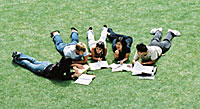|
 |
|
 |
| |
| |
| |
| |
| |
| |
| |
Campus: Kensington Campus
| |
| |
Career: Undergraduate
| |
| |
Units of Credit: 6
| |
| |
| |
| |
Indicative Contact Hours per Week: 3
| |
| |
| |
| |
| |
 |
|
 |
Description
The historical context for the making of modern Australia, 1850-1901. What was the 19th century experience of Aboriginal people? Where does the Republican Movement find its Australian origins? What do recent stereotypes of masculinity and femininity owe to our colonial past? How has history shaped definitions and expressions of sexuality? What are the origins of our current political system? Charts Australia's development from an isolated colony to an independent nation.
Learning Outcomes
Students who actively participate in and successfully complete the course will:
- Gain an understanding of the major and iconic developments, events and themes in Australian history between 1850 and 1901
- Be able to connect these developments, event and themes both with one another and with subsequent and present-day developments and debates
- Be introduced to a number of theoretical, disciplinary and historiographical approaches, including those dealing with race, gender, ethnicity, material culture, cultural and political history and environmental history
- Understand that the past can be explored not only through books and documents, but through a wide range of forms such as architecture, art, photographs, archaeology and other forms of material culture
- Gain skills in primary and secondary research, analysis and writing
- Gain skills in critical review and analysis and understand the role of evidence in historical debate
- Gain skills in communicating ideas effectively in both verbal and written form
- Experience personal development through both independent and cooperative activities and exercises.
Assessment
- Research essay (2500 words) - 35%
- Research essay precis (300 words) - 5%
- Tutorial paper (1000 words) - 20%
- End of session test - 20%
- Participation - 20%
|



